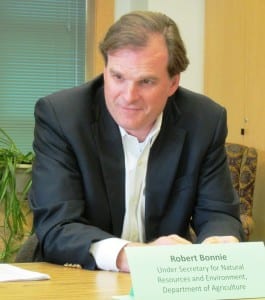The Tongass Advisory Committee has been working for almost a year on a set of recommendations to help the U.S. Forest Service transition to second-growth timber. At the start of a three-day meeting in Ketchikan, members said they were confident their recommendations could lead to success, but they aren’t confident that the Forest Service will take those recommendations to heart.
The Tongass Advisory Committee is supposed to talk about how best to move away from logging old-growth forest, replacing that with second-growth. They’ve talked about buffer zones, suitable areas for harvest, unsuitable areas, etc., but among their recommendations is an overhaul of how the U.S. Forest Service does timber.
That overhaul includes engaging outside groups, such as the timber industry and environmentalists; working with neighboring land owners to maximize the economic value of a timber sale; helping sawmills switch out their infrastructure to accommodate smaller trees; and making the timber sale process more transparent, and more efficient.
Committee members think all that’s going to be a hard sell. Here’s Carol Rushmore,  economic development director for the City of Wrangell, a local government representative on the committee.
economic development director for the City of Wrangell, a local government representative on the committee.
“They’re so entrenched in their ways, and there are so many rules that they have to follow,” she said. “Can what we’re asking actually be done? And therein lies my frustration and my doubts.”
Brian McNitt works with the Sitka-based Alaska Conservation Foundation, and represents environmental concerns. He, too, wasn’t sure how the Forest Service might be able to adapt to the recommendations.
“I think that the culture at the Forest Service and within the timber industry in Southeast, and in the communities to some degree, has been set over a long period of time,” he said. “Unless there is a very clear intent to change, or a real clear on what we’re OK with on old growth, I don’t think we’re going to see a change.”
And then there’s the timber industry. Wade Zammit for many years was president of Sealaska Timber Corp. He also said figuring out how best to implement the recommendations could be a sticking point.
“It’s all bad,” he said of the Forest Service process. “So, how can you make young growth better without making it all better? It’s all going to be fixed.”
 Robert Bonnie is Undersecretary for Natural Resources and Environment for the U.S. Department of Agriculture. He was in town for the meeting, but before heading over for the afternoon session, he joined Alaska Regional Forester Beth Pendleton and new Tongass Forest Supervisor Earl Stewart at a news conference.
Robert Bonnie is Undersecretary for Natural Resources and Environment for the U.S. Department of Agriculture. He was in town for the meeting, but before heading over for the afternoon session, he joined Alaska Regional Forester Beth Pendleton and new Tongass Forest Supervisor Earl Stewart at a news conference.
I asked for their response to the committee’s doubts. Bonnie said he understands the skepticism, but the agency has gotten the message, loud and clear. He said officials want to work with the committee to improve the system.
“The committee’s talked about things like effectiveness monitoring, to make sure that the things that we’re doing on the ground actually work,” Bonnie said. “And that we have a credible monitoring program to measure those things. And not just monitoring the forest management impacts, but the social and economic impacts, as well. We take that very seriously.”
Pendleton added that she and other officials sat down last week with some committee members, and they discussed forming a monitoring council to keep the Forest Service on track.
Pendleton said she recognizes that the Forest Service is going to have to make some changes, and they’re already working toward that to some degree.
For example, she said they’re working with State of Alaska and private landholders to
discuss restoration projects, and collaboration on timber.
“I give as an example, Kosciusko Island, which now will have a significant amount of the lands that have gone to Sealaska. The Forest Service still retains lands there, as well as state lands,” she said. “So we are in a landowners group now. Looking at that landscape, and working with the community of Edna Bay, in a more collaborative fashion, to look at the opportunities for future second-growth, young-growth harvest.”
The big goal everyone said they support is maintaining what’s left of the Southeast Alaska logging industry during the transition.
The Tongass Advisory Committee meets again Thursday at the Ted Ferry Civic Center, with a public comment period set for 8:30 a.m. It’s hoped members will be able to officially approve recommendations in time to include them in the Tongass Land Management Plan amendment process. There is a potential vote on those recommendations scheduled for Thursday afternoon.









